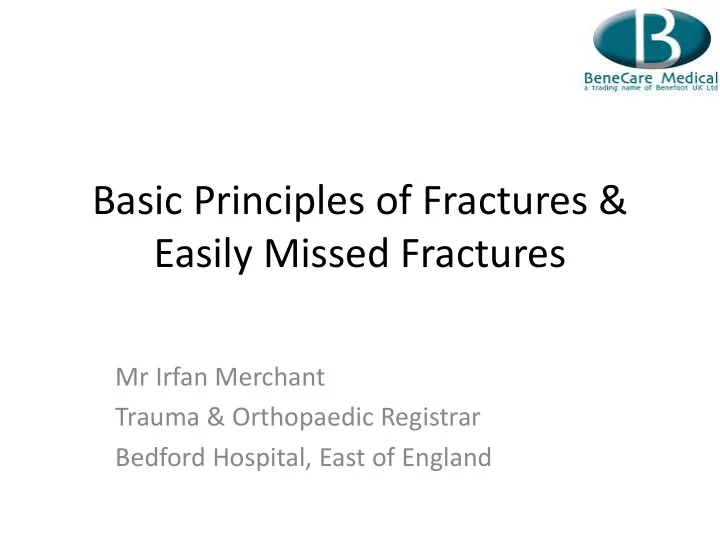

Basic Principles of Fractures & Easily Missed Fractures Mr Irfan Merchant Trauma & Orthopaedic Registrar Bedford Hospital, East of England
Objectives • Types • Fracture Patterns • Fracture Healing • Assessing a fracture • Treatment Principles • Missed fractures – upper limb • Missed fractures – lower limb
Definition • Break in continuity of bone
Types • Simple/closed vs Compound/open • Incomplete vs complete • Displaced vs undisplaced • Traumatic vs pathological • Fracture pattern – Linear vs comminuted vs segmental
Something to consider • Greenstick – children • Stress fracture – athletes • Fatigue fracture – occupations – police • Pathological fracture - elderly
Fracture healing • Begins to heal as soon as bone broken provided conditions are favourable • Absolute vs relative stability
Assessing a fracture • History • Age, sex, hand dominance, mechanism of injury • Examination – Look/feel/move • Documentation • Investigation • Emergency management • Definitive management
Rules in X-Ray • Better none than one view • X-ray is a shadow – conceals and distorts so interpret with caution • Joint above and below • Read x-rays in anatomical position • Exposure should be adequate
Treatment Principles • GOAL – restore anatomy back to normal or near to normal as possible • Resuscitation • Reduction • Immobilisation/Fixation • Rehabilitation
Reduction • Closed vs open
Immobilisation • Conservative vs Surgical
Importance of history • Mechanism of injury • Reverse force for reduction • Look at pattern and location to choose most appropriate management
Common Missed fracture – Upper Limb
MALLET FINGER
VOLAR PLATE FRACTURE
BOXER’S FRACTURE
Bennett’s Fracture
Skier’s Thumb
SCAPHOID FRCATURE
TRIQUETRAL FRACTURE
BUCKLE FRACTURE
GREENSTICK FRACTURE
RADIAL HEAD FRACTURE
FAT PAD SIGN
AVULSION OF THE MEDIAL EPICONDYLE
Common Missed fracture – Lower Limb Censored
PUBIC RAMI FRACTURE
Malgaigne Fracture
Pubic Diastasis
Acetabular fracture
HOW MANY ABNORMALITIES?
Bilateral superior and inferior pubic rami fractures and right sacral ala fracture. Normal SI joint and pubic symphysis alignment. Several sharp foreign bodies with appearance and density consistent with glass are projected near the left hip.
Hip and Proximal femur Look for: • A black line – a displaced fracture • A white line – impacted fracture • A fracture line through the subcapital region, through the trochanteric region or through the subtrochanteric region Check: • If cortical margins of the femoral neck smooth and continuous, or is there a slight step • Lateral radiograph
Impacted fracture
Intertrochanteric frcature
CAN YOU SPOT THE FRACTURE
Lateral view of the same patient
Knee AP view – look for: • The ‘ intercondylar eminence’ ( ie the tibial spines) of the tibia and the condylar surfaces of the femur • The head and neck of the fibula • The tibial plateau – should be smooth, no steps, no layering, no disruption • The subchondral bone should not show any focal increase in density • The patella – look through the superimposed femur • Any small fragments of bone anywhere
Knee Lateral view – Look for • Joint effusion – present if the suprapatellar strip exceeds 5mm • Fat-fluid level in the suprapatellar bursa – an intra-articular fracture • Condylar surfaces of the femur – are they smooth • The patella – is the articular surface smooth • The position of the patella • Small boney fragments
Fat Fluid Level
TIBIAL PLATEAU FRACTURE AP of the same the patient
CT Scan of Tibial Plateau fracture
CT Scan of Tibial Plateau fracture
PATELLA FRACTURE NOTE: SKYLINE VIEW MIGHT BE NEEDED FOR PATELLA FRACTURES
Head of fibula fracture
Ankle AP Mortice view – look for • Malleoli – fracture – medial, lateral • Talus – Dome - ?smooth • Joint width - ?talar shift
DESCRIBE THE RADIOGRAPH
• Spiral fracture through the distal fibula. Fracture line through the ankle joint in keeping with a Weber B, with slight lateral talar shift (widening of medial clear space). • Well-corticated ossicle distal to the medial malleolus may be post-traumatic or congenital (i.e. an accessory ossicle).
DESCRIBE THE RADIOGRAPH
Insufficiency fracture Fracture in the abnormal bone with normal stresses. Common site: • Vertebra, • Pelvis – Sacrum , Pubic bone • Neck of femur • Calcaneum
Calcaneum fracture
Stress fracture Fatigue fracture • Normal bone with abnormal stresses • Common in lower limbs. Change in physical activity • Not apparent on plain films. May take weeks to appear on Plain radiographs • MRI shows them as bone oedema • Increased activity on the NM scan
MRI of Stress Fracture
Stress Fracture
Radiograph and Bone scan of Stress Fracture
Learning points
Important points When looking at the x-ray: • Look at all four corners • DO NOT be content if you have spotted one fracture • Follow outline of all bones • Look at the soft tissue signs
Thank You
Recommend
More recommend